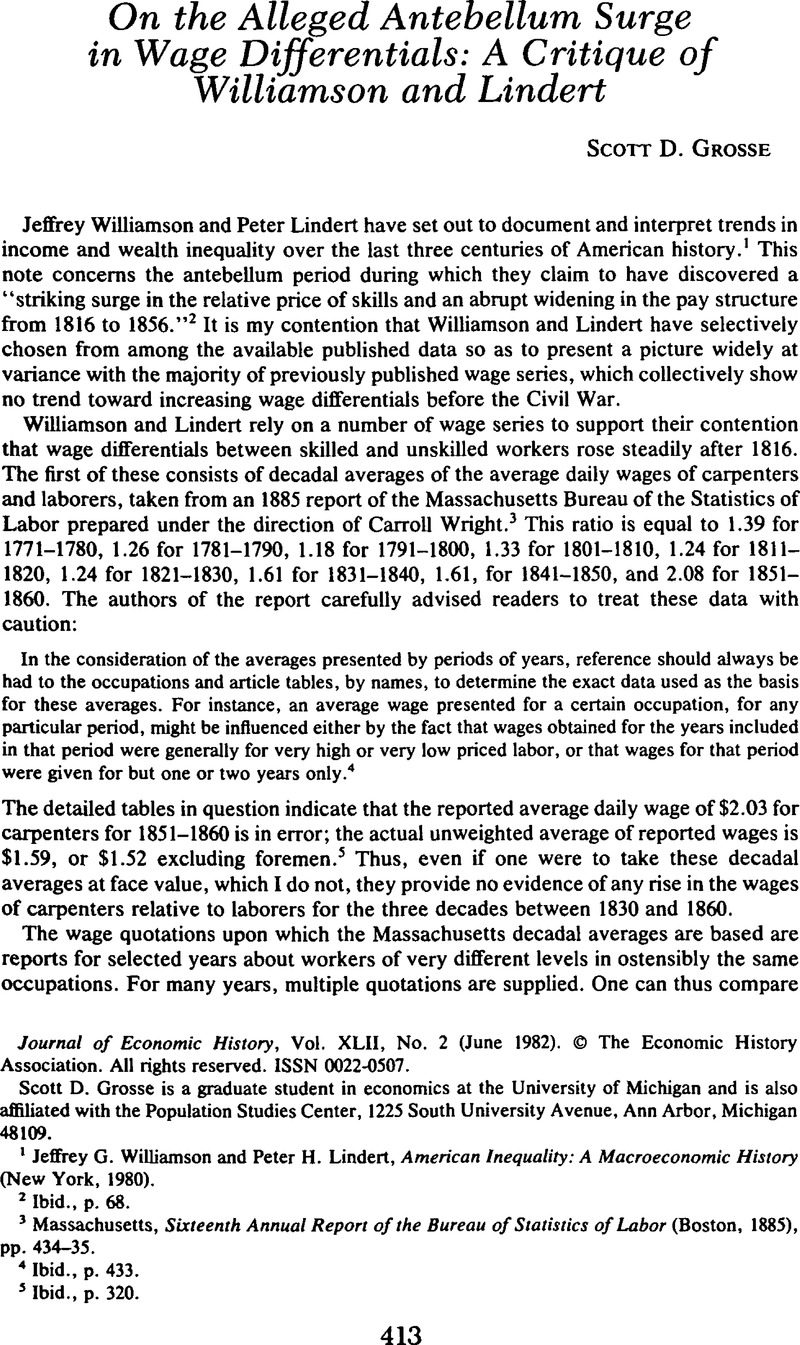Article contents
On the Alleged Antebellum Surge in Wage Differentials: A Critique of Williamson and Lindert
Published online by Cambridge University Press: 03 March 2009
Abstract

- Type
- Notes and Discussion
- Information
- Copyright
- Copyright © The Economic History Association 1982
References
1 Williamson, Jeffrey G. and Lindert, Peter H., American Inequality: A Macroeconomic History (New York, 1980).Google Scholar
2 Ibid., p. 68.
3 Massachusetts, , Sixteenth Annual Report of the Bureau of Statistics of Labor (Boston, 1885), pp. 434–35.Google Scholar
4 Ibid., p. 433.
5 Ibid., p. 320.
6 Ibid., pp. 319–25. Lindert, and Williamson, directed my attention to United States Bureau of Labor Statistics, History of Wages in the United States from Colonial Times to 1928 (Washington, D.C., 1929), p. 58, with a table reprinting the relevant data for 1800–1838.Google Scholar
7 Zabler, Jeffrey F., “Further Evidence on American Wage Differentials, 1800–1830,” Explorations in Economic History, 10 (Fall 1972), 109–17.Google Scholar
8 Ibid., pp. 112–13.
9 Smith, Adam, An Inquiry into the Nature and Causes of the Wealth of Nations, 6th ed., Cannan, E., ed. (London, 1950), pp. 71–72.Google Scholar
10 U. S. Bureau of Labor Statistics, History of Wages, p. 53.Google Scholar
11 Adams, Donald R., “Wages Rates in the Early National Period: Philadelphia, 1785–1830,” this JOURNAL, 28 (09 1968), 404–26.Google Scholar
12 Ibid., p. 411.
13 Zabler, “Further Evidence,” p. 115.Google Scholar
14 Williamson and Lindert, American Inequality, p. 70.Google Scholar
15 U. S. Bureau of Labor Statistics, History of Wages, p. 70.Google Scholar
16 Burgess, W. R., Trends in School Costs (New York, 1920), cited in Williamson and Lindert, American Inequality, p. 305.Google Scholar
17 Katz, Michael B., The Irony of Early School Reform (Cambridge, Massachusetts, 1968), p. 224;Google ScholarKaestle, Carl F. and Vinovskis, Mans A., Education and Social Change in Nineteenth-Century Massachusetts (New York, 1980), p. 284.CrossRefGoogle Scholar
18 “… what compensation do teachers receive? Not half so much as is ordinarily given to headmen and master-workmen in the handicrafts and trades; not one-third, often not one-fourth part so much as is paid to cashiers of banks, or secretaries of insurance companies, or overseers in factories, or engineers on rail-roads.” Massachusetts, , Eighth Annual Report of the Board of Education (Boston, 1846), p. 31.Google Scholar “In 1837, only a few of the public schools in the State were kept during the whole year. The average compensation given to teachers—especially to female teachers—was disreputably low. At once to increase the length of the schools and to add to the compensation of teachers, it became necessary to enlarge the annual appropriations.” Massachusetts, , Ninth Annual Report of the Board of Education (Boston, 1847), p. 68.Google Scholar
19 Wright, Carroll D., Comparative Wages, Prices, and Cost of Living (Boston, 1889), pp. 22, 54, 55, and 185.Google Scholar
20 Williamson and Lindert, American Inequality, p. 71.Google Scholar
21 Massachusetts, Sixteenth Annual Report of the Bureau of Statistics of Labor, pp. 325–26.Google Scholar
22 Coelho, Philip R. P. and Shepherd, James F., “Regional Differences in Real Wages: The United States, 1851–1880,” Explorations in Economic History, 13 (04 1976), 203–30.CrossRefGoogle Scholar
23 Ibid., p. 228.
24 Williamson and Lindert, American Inequality, pp. 69, 306. Data are from Burgess, Trends in School Costs.Google Scholar
25 Williamson and Lindert, American Inequality, p. 68.Google Scholar
26 Ibid., p. 70.
27 Aldrich, Mark, “Earnings of American Civil Engineers, 1820–1859,” this JOURNAL, 31 (06 1971), 407–19.Google Scholar
28 Ibid., pp. 415–16.
29 Ibid., pp. 409–10; Smith, Walter B., “Wage Rates on the Erie Canal, 1828–1881,” this JOURNAL, 23 (09 1963), 298–311.Google Scholar
30 Nickless, Pamela J., “A New Look at Productivity in the New England Cotton Textile Industry,” this JOURNAL, 39 (12 1979), 889–910.Google Scholar
31 Smith, “Wage Rates,” pp. 303–04.Google Scholar
32 The Smith data and the Adams data are reprinted in the U.S. Bureau of the Census, Historical Statistics of the United States (Washington, D.C., 1976).Google Scholar
33 Williamson and Lindert, American Inequality, p. 70.Google Scholar The source is Layer, Robert G., Earnings of Cotton Mill Earnings, 1825–1914 (Cambridge, Massachusetts, 1955), p. 52.Google Scholar
34 Ibid.
35 Nickless, “A New Look,” p. 909.Google Scholar
36 Ibid., pp. 907–08.
- 4
- Cited by


